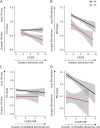Differential Effects of APOE and Modifiable Risk Factors on Hippocampal Volume Loss and Memory Decline in Aβ- and Aβ+ Older Adults
- PMID: 35169009
- PMCID: PMC9071368
- DOI: 10.1212/WNL.0000000000200118
Differential Effects of APOE and Modifiable Risk Factors on Hippocampal Volume Loss and Memory Decline in Aβ- and Aβ+ Older Adults
Abstract
Background and objectives: This prospective study sought to determine the association of modifiable/nonmodifiable components included in the Cardiovascular Risk Factors, Aging, and Incidence of Dementia (CAIDE) risk score with hippocampal volume (HV) loss and episodic memory (EM) decline in cognitively normal (CN) older adults classified as brain β-amyloid (Aβ) negative (Aβ-) or positive (Aβ+).
Methods: Australian Imaging, Biomarkers and Lifestyle study participants (age 58-91 years) who completed ≥2 neuropsychological assessments and a brain Aβ PET scan (n = 592) were included in this study. We computed the CAIDE risk score (age, sex, APOE ε4 status, education, hypertension, body mass index [BMI], hypercholesterolemia, physical inactivity) and a modifiable CAIDE risk score (CAIDE-MR; education, hypertension, BMI, hypercholesterolemia, physical inactivity) for each participant. Aβ+ was classified using Centiloid >25. Linear mixed models assessed interactions between each CAIDE score, Aβ group, and time on HV loss and EM decline. Age, sex, and APOE ε4 were included as separate predictors in CAIDE-MR models to assess differential associations. Exploratory analyses examined relationships between individual modifiable risk factors and outcomes in Aβ- cognitively normal (CN) adults.
Results: We observed a significant Aβ group × CAIDE × time interaction on HV loss (β [SE] = -0.04 [0.01]; p < 0.000) but not EM decline (β [SE] = -2.33 [9.96]; p = 0.98). Decomposition revealed a significant CAIDE × time interaction in Aβ+ participants only. When modifiable/nonmodifiable CAIDE components were considered separately, we observed a significant Aβ group × CAIDE-MR × time interaction on EM decline only (β [SE] = 3.03 [1.18]; p = 0.01). A significant CAIDE-MR score × time interaction was observed in Aβ- participants only. Significant interactions between APOE ε4 and age × time on HV loss and EM decline were observed in both groups. Exploratory analyses in Aβ- CN participants revealed a significant interaction between BMI × time on EM decline (β [SE] = -3.30 [1.43]; p = 0.02).
Discussion: These results are consistent with studies showing that increasing age and APOE ε4 are associated with increased rates of HV loss and EM decline. In Aβ- CN adults, lower prevalence of modifiable cardiovascular risk factors was associated with less HV loss and EM decline over ∼10 years, suggesting interventions to reduce modifiable cardiovascular risk factors could be beneficial in this group.
© 2022 American Academy of Neurology.
Figures


Similar articles
-
Association of β-Amyloid and Apolipoprotein E ε4 With Memory Decline in Preclinical Alzheimer Disease.JAMA Neurol. 2018 Apr 1;75(4):488-494. doi: 10.1001/jamaneurol.2017.4325. JAMA Neurol. 2018. PMID: 29356823 Free PMC article.
-
Amyloid-Related Memory Decline in Preclinical Alzheimer's Disease Is Dependent on APOE ε4 and Is Detectable over 18-Months.PLoS One. 2015 Oct 2;10(10):e0139082. doi: 10.1371/journal.pone.0139082. eCollection 2015. PLoS One. 2015. PMID: 26430784 Free PMC article.
-
Differential Effects of the Interaction Between the Education and APOE ε4 Allele on Amyloid-beta Retention and Memory Performances in Cognitively Normal Older Adults and Alzheimer's Disease Patients.Curr Alzheimer Res. 2020;17(11):1023-1032. doi: 10.2174/1567205017666201229113416. Curr Alzheimer Res. 2020. PMID: 33372875
-
Association of Brain Amyloid-β With Slow Gait in Elderly Individuals Without Dementia: Influence of Cognition and Apolipoprotein E ε4 Genotype.JAMA Neurol. 2017 Jan 1;74(1):82-90. doi: 10.1001/jamaneurol.2016.3474. JAMA Neurol. 2017. PMID: 27842173 Free PMC article.
-
Modifiable risk factors for dementia and dementia risk profiling. A user manual for Brain Health Services-part 2 of 6.Alzheimers Res Ther. 2021 Oct 11;13(1):169. doi: 10.1186/s13195-021-00895-4. Alzheimers Res Ther. 2021. PMID: 34635138 Free PMC article. Review.
Cited by
-
Correlation between the APOE ε4 genotype, lifestyle habits, and cognitive deficits in Chinese adults over 60: a cross-sectional analysis in China.Front Public Health. 2024 Nov 21;12:1417499. doi: 10.3389/fpubh.2024.1417499. eCollection 2024. Front Public Health. 2024. PMID: 39639910 Free PMC article.
-
The association of subjective sleep characteristics and plasma biomarkers of Alzheimer's disease pathology in older cognitively unimpaired adults with higher amyloid-β burden.J Neurol. 2023 Jun;270(6):3008-3021. doi: 10.1007/s00415-023-11626-0. Epub 2023 Feb 20. J Neurol. 2023. PMID: 36806992
-
Soluble Aβ pathology predicts neurodegeneration and cognitive decline independently on p-tau in the earliest Alzheimer's continuum: Evidence across two independent cohorts.Alzheimers Dement. 2025 Feb;21(2):e14415. doi: 10.1002/alz.14415. Epub 2025 Feb 3. Alzheimers Dement. 2025. PMID: 39898436 Free PMC article.
-
Association between healthy lifestyle and memory decline in older adults: 10 year, population based, prospective cohort study.BMJ. 2023 Jan 25;380:e072691. doi: 10.1136/bmj-2022-072691. BMJ. 2023. PMID: 36696990 Free PMC article.
-
Matrix Remodeling Enzymes as Potential Fluid Biomarkers of Neurodegeneration in Alzheimer's Disease.Int J Mol Sci. 2024 May 24;25(11):5703. doi: 10.3390/ijms25115703. Int J Mol Sci. 2024. PMID: 38891891 Free PMC article.
References
-
- Lim YY, Williamson R, Laws SM, et al. . Effect of APOE genotype on amyloid deposition, brain volume, and memory in cognitively normal older individuals. J Alzheimers Dis. 2017;58(4):1293-1302. - PubMed
-
- Villemagne VL, Burnham S, Bourgeat P, et al. . Amyloid β deposition, neurodegeneration, and cognitive decline in sporadic Alzheimer's disease: a prospective cohort study. Lancet Neurol. 2013;12(4):357-367. - PubMed
MeSH terms
Substances
LinkOut - more resources
Full Text Sources
Medical
Miscellaneous
